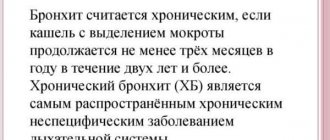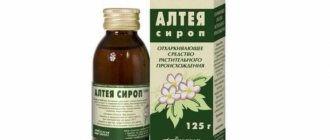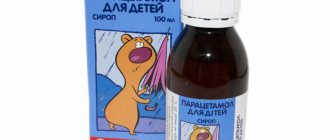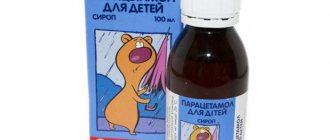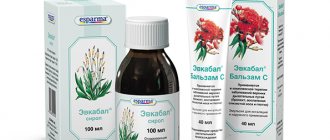Compound
| Syrup | 10 ml |
| active substances: | |
| salbutamol sulfate (equivalent to salbutamol) | 2 mg |
| Bromhexine hydrochloride | 4 mg |
| guaifenesin | 100 mg |
| excipients: sucrose (sugar); sorbitol (70% solution); glycerol (glycerol); propylene glycol; sodium benzoate; citric acid monohydrate; sorbic acid; dye “Sunset” yellow (FCF); menthol (levomenthol); blackcurrant flavor (blackcurrant flavor ID20158); pineapple flavor (pineapple flavor super “PH”); purified water |
Side effects
Ascoril rarely causes adverse reactions in the body and is well tolerated by children and adults. In some cases it is possible:
- impaired taste, dry mouth;
- loss of appetite, nausea;
- cramps in the stomach;
- tremor;
- increased drowsiness;
- nervous excitability;
- headache.
In isolated cases, there is a change in the color of urine - pink. In case of allergic reactions to the drug, urticaria, skin itching, red spots, and swelling of the mucous membranes may appear.
Pharmacodynamics
The combined drug has a bronchodilator, expectorant and mucolytic effect.
Salbutamol is a bronchodilator that stimulates beta2-adrenergic receptors of the bronchi, blood vessels and myometrium. Prevents or eliminates bronchospasm, reduces resistance in the respiratory tract, increases the vital capacity of the lungs. Causes expansion of the coronary arteries, does not reduce blood pressure.
Bromhexine is a mucolytic agent. Has an expectorant effect, improves sputum discharge.
Guaifenesin is a mucolytic agent that reduces the surface tension of the structures of the bronchopulmonary apparatus; stimulates secretory cells of the bronchial mucosa that produce neutral polysaccharides, depolymerizes acidic mucopolysaccharides, reduces the viscosity of sputum, facilitates the removal of sputum and promotes the transition of a non-productive cough to a productive one.
How does Ascoril work?
Bromhexin and guaifenesin stimulate the production of the serous component of secretory mucus in the bronchi. Due to this, the volume of sputum increases, it becomes less viscous and thick, and is easier to separate when coughing. Salbutamol reduces the activity of receptors that cause spasm of the walls of the respiratory tract, promotes the expansion of the bronchial lumen, and facilitates breathing.
Ascoril has a complex bronchodilator, mucolytic and antispasmodic effect:
- stimulates the work of epithelial cilia, pushing mucus upward;
- dilutes and facilitates secretion removal;
- increases the productivity of wet cough, promotes the transition of dry to productive;
- increases lung volume;
- reduces the number of convulsive coughing attacks that interfere with the normal discharge of mucus.
The drug does not contain codeine or similar substances that affect specific centers of the brain. It is recommended to use it for diseases accompanied by increased production of mucous secretions. Ascoril does not affect the duration and intensity of pathologies; it acts directly on the area of the lungs and bronchi.
Pharmacokinetics
Salbutamol
When taken orally, absorption is high. Eating reduces the rate of absorption but does not affect bioavailability. Communication with plasma proteins - 10%. Penetrates through the placenta. Subjected to first-pass metabolism in the liver and intestinal wall, it is inactivated by phenol sulfotransferase to 4-o-sulfate ester. T1/2 - 3.8–6 hours. Excreted by the kidneys (69–90%), mainly in the form of an inactive phenol sulfate metabolite (60%) within 72 hours and with bile (4%). The bioavailability of orally administered salbutamol is about 50%.
Bromhexine
When taken orally, it is almost completely (99%) absorbed into the gastrointestinal tract within 30 minutes. Bioavailability is low (first pass effect through the liver). Penetrates through the placental barrier and BBB. In the liver it undergoes demethylation and oxidation, metabolized to the pharmacologically active ambroxol. T1/2 - 15 hours (due to slow reverse diffusion from tissues). Excreted by the kidneys. With chronic renal failure, the excretion of metabolites is impaired. May accumulate with repeated use.
Guaifenesin
Absorption from the gastrointestinal tract is rapid (25–30 minutes after oral administration). T1/2 - 1 hour. Penetrates tissues containing acidic mucopolysaccharides. Approximately 60% of the administered drug is metabolized in the liver. It is excreted by the lungs (with sputum) and the kidneys both unchanged and in the form of inactive metabolites.
Ascoril 200ml syrup
pharmachologic effect
Combination expectorant.
Composition and release form Ascoril 200ml syrup
Syrup - 10 ml:
- Active ingredients: salbutamol (in the form of sulfate) - 2 mg; bromhexine hydrochloride - 4 mg; guaifenesin - 100 mg;
- Excipients: sucrose (sugar), sorbitol (70% solution), glycerol (glycerin), propylene glycol, sodium benzoate, citric acid monohydrate, sorbic acid, sunset yellow (FCF), menthol (levomenthol), blackcurrant flavor (black fragrance currant ID 20158), pineapple flavor (pineapple flavor super “PH”), purified water.
100 or 200 ml - dark plastic bottles (1) complete with a measuring cap - cardboard packs.
Description of the dosage form
Syrup in the form of a transparent, orange, viscous liquid with a specific odor.
Directions for use and doses
The drug is taken orally.
Adults and children over 12 years of age are prescribed 1 tablet. 3 times/day or 10 ml of Ascoril expectorant syrup (2 teaspoons) 3 times/day.
Children aged 6 to 12 years – 1/2 or 1 tablet. 3 times/day or 5-10 ml of Ascoril expectorant syrup (1-2 teaspoons) 3 times/day.
For children under 6 years of age, it is recommended to use Ascoril expectorant syrup 5 ml (1 teaspoon) 3 times a day.
Pharmacodynamics
A combined drug with bronchodilator, expectorant and mucolytic effects.
Salbutamol is a bronchodilator that stimulates β2-adrenergic receptors of the bronchi, blood vessels and myometrium. Prevents or eliminates bronchospasm, reduces resistance in the respiratory tract, increases the vital capacity of the lungs. Causes expansion of the coronary arteries, does not reduce blood pressure.
Bromhexine is a mucolytic agent, has an expectorant effect, improves sputum discharge.
Guaifenesin is a mucolytic agent that reduces the surface tension of the structures of the bronchopulmonary apparatus; stimulates secretory cells of the bronchial mucosa that produce neutral polysaccharides, depolymerizes acidic mucopolysaccharides, reduces the viscosity of sputum, activates the ciliary apparatus of the bronchi, facilitates the removal of sputum and promotes the transition of an unproductive cough to a productive one.
Pharmacokinetics
Salbutamol
Suction and distribution
When taken orally, absorption is high. The bioavailability of salbutamol when taken orally is about 50%. Eating reduces the rate of absorption but does not affect bioavailability. Plasma protein binding - 10%. Penetrates through the placental barrier.
Metabolism and excretion
Subjected to first-pass metabolism in the liver and in the intestinal wall, it is inactivated by phenolsulfotransferase to 4-o-sulfate ester. T1/2 - 3.8-6 hours. Excreted by the kidneys (69-90%), mainly in the form of an inactive phenol sulfate metabolite (60%) within 72 hours and with bile (4%).
Bromhexine
Suction and distribution
When taken orally, it is almost completely (99%) absorbed from the gastrointestinal tract within 30 minutes. Bioavailability is low (because it is subject to the “first pass” effect through the liver). Penetrates through the placental barrier and BBB.
Metabolism and excretion
In the liver it undergoes demethylation and oxidation, metabolized to the pharmacologically active ambroxol. T1/2 - 15 hours (due to slow reverse diffusion from tissues). Excreted by the kidneys.
In chronic renal failure, the excretion of metabolites is impaired. May accumulate with repeated use.
Guaifenesin
Suction and distribution
Absorption from the gastrointestinal tract is rapid (25-30 minutes after oral administration). Penetrates into tissues containing acidic mucopolysaccharides.
Metabolism and excretion
Approximately 60% of the administered drug is metabolized in the liver.
T1/2 - 1 hour. Excreted by the lungs (with sputum) and the kidneys, both unchanged and in the form of inactive metabolites.
Indications for use Ascoril 200ml syrup
As part of combination therapy for acute and chronic bronchopulmonary diseases accompanied by the formation of difficult-to-separate viscous secretions:
- bronchial asthma;
- tracheobronchitis;
- obstructive bronchitis;
- pneumonia;
- emphysema;
- whooping cough;
- pneumoconiosis;
- pulmonary tuberculosis.
Contraindications
- hypersensitivity to the components of the drug;
- pregnancy, lactation period;
- tachyarrhythmia, myocarditis;
- heart defects;
- decompensated diabetes mellitus;
- thyrotoxicosis;
- glaucoma;
- liver or kidney failure;
- peptic ulcer of the stomach and duodenum in the acute phase;
- stomach bleeding;
- arterial hypertension (for the use of tablets);
- children under 6 years of age (for use of tablets).
The drug in tablet form is prescribed with caution to patients with diabetes mellitus, gastric and duodenal ulcers in remission.
Use of Ascoril 200ml syrup during pregnancy and breastfeeding
It is not recommended to use the drug during pregnancy.
If treatment with the drug is necessary during lactation, breastfeeding should be discontinued.
Contraindication for the use of tablets: children under 6 years of age.
Overdose
Symptoms: possible increased side effects.
Treatment: symptomatic therapy.
Side effects of Ascoril 200ml syrup
Rarely: when used in high doses, headache, dizziness, increased nervous excitability, sleep disturbance, drowsiness, tremor, convulsions, nausea, vomiting, diarrhea, exacerbation of gastric and duodenal ulcers, rapid heartbeat, possible pink coloration of urine are sometimes observed. , allergic reactions (rash, urticaria), collapse, bronchospasm.
Drug interactions
Other beta2-adrenergic agonists and theophylline enhance the effect of salbutamol and increase the likelihood of side effects.
Ascoril is not prescribed simultaneously with drugs containing codeine and other antitussives, because this makes it difficult to clear liquefied sputum.
Bromhexine, which is part of the drug Ascoril, promotes the penetration of antibiotics (erythromycin, cephalexin, oxytetracycline) into the lung tissue.
It is not recommended to use Ascoril simultaneously with non-selective beta-adrenergic receptor blockers, such as propranolol.
Salbutamol, which is part of the drug Ascoril, is not recommended for patients receiving monoamine oxidase inhibitors (MAOIs).
Diuretics and glucocorticosteroid preparations enhance the hypokalemic effect of salbutamol.
It is not recommended to take alkaline drinks at the same time as Ascoril.
Interaction
Other beta2-adrenergic agonists and theophylline enhance the effect of salbutamol and increase the likelihood of side effects.
Ascoril expectorant is not prescribed simultaneously with drugs containing codeine and other antitussives, because this makes it difficult to clear liquefied sputum.
Bromhexine, which is part of the drug, promotes the penetration of antibiotics (erythromycin, cephalexin, oxytetracycline) into the lung tissue.
It is not recommended to use the drug simultaneously with non-selective beta-adrenergic blockers such as propranolol.
Salbutamol, which is part of the drug, is not recommended for patients receiving MAO inhibitors.
Diuretics and corticosteroids enhance the hypokalemic effect of salbutamol.
It is not recommended to take alkaline drinks simultaneously with the drug Ascoril expectorant.
When to use Ascoril: instructions
The solution and the medication in tablets have the same indications:
- symptoms of viral or bacterial pneumonia: deep wheezing in the lungs, difficulty breathing, cough with thick, difficult-to-clear sputum;
- acute or chronic infectious bronchitis;
- obstructive bronchial disease;
- asthmatic damage to the bronchi;
- bronchitis of unknown origin, accompanied by cough and breathing difficulties;
- tracheitis.
Ascoril is ineffective for prolonged dry cough caused by irritation of receptors, not accompanied by the production of mucous secretion.
Contraindications
It is necessary to stop using the drug:
- with exacerbations of gastritis and peptic ulcer;
- with stomach or intestinal bleeding;
- insulin-dependent diabetes mellitus;
- thyrotoxicosis;
- glaucoma;
- myocarditis;
- severe stage of urolithiasis;
- liver or kidney failure.
The product is also prohibited for pregnant and lactating women, as it penetrates into all tissues of the body and breast milk. Ascoril tablets are contraindicated in children under 6 years of age. Syrup - for infants and children up to 2 years old.
